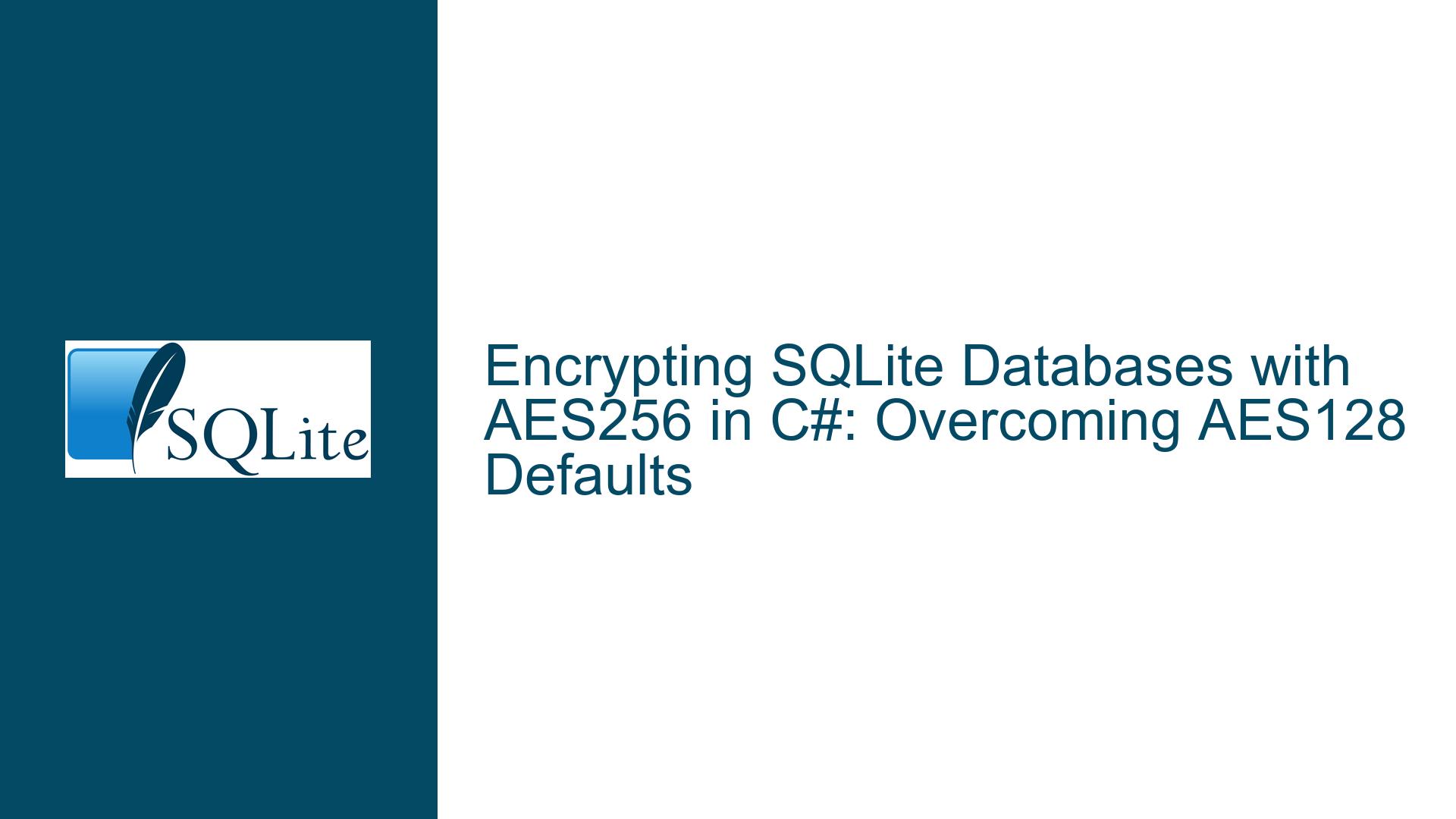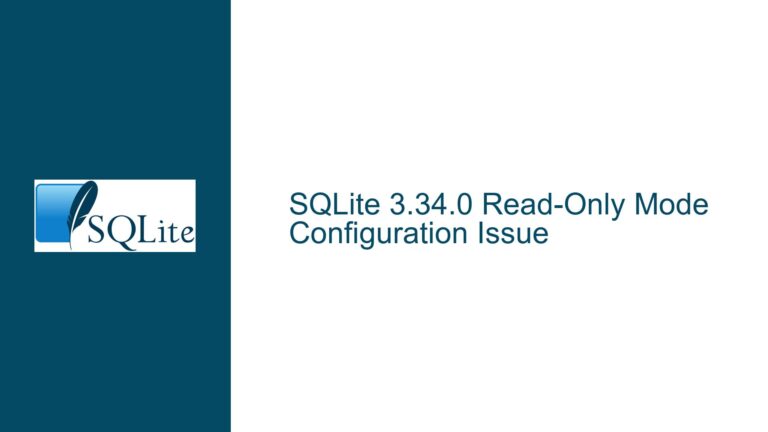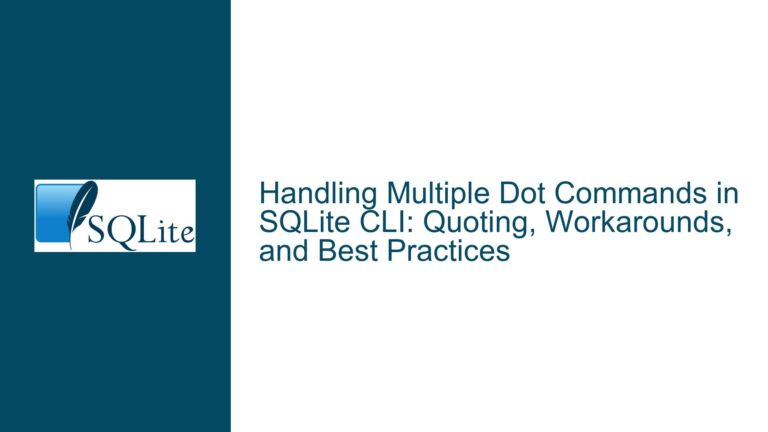Encrypting SQLite Databases with AES256 in C#: Overcoming AES128 Defaults
Issue Overview: AES256 Encryption Challenges in SQLite C# NuGet Packages
The core issue revolves around configuring SQLite databases to use AES256 encryption when working with C# NuGet packages. By default, many SQLite implementations—including those interfaced via popular .NET libraries—employ AES128 for database encryption. This creates a gap between developer expectations (AES256 compliance for stricter security requirements) and the actual cryptographic capabilities of their chosen libraries. The problem is compounded by fragmented documentation, ambiguous package dependencies, and subtle differences in how encryption is handled across SQLite forks like SQLCipher, SEE (SQLite Encryption Extension), and vanilla SQLite.
AES256 encryption requires a 256-bit key, whereas AES128 uses a 128-bit key. While both algorithms are secure, AES256 is often mandated in industries with stringent data protection standards. The challenge arises because the default SQLite engine does not natively support encryption; it relies on third-party extensions or modified builds. In C#, the most common NuGet packages for SQLite interaction—such as Microsoft.Data.Sqlite, System.Data.SQLite, or wrappers around SQLCipher—have varying degrees of support for AES256. For instance, System.Data.SQLite historically used AES128 in its encryption API, while SQLCipher-based packages default to AES256 but require explicit configuration.
A critical sub-issue is the conflation of encryption strength with key derivation mechanisms. Even when a library claims AES256 support, improper key derivation (e.g., using fewer iterations of PBKDF2) can weaken security. Developers must ensure that both the cipher algorithm and the key derivation process align with their security requirements.
Possible Causes: Why AES256 Might Fail or Default to AES128
1. Underlying SQLite Build Limitations
Many C# NuGet packages bundle a specific SQLite build. If the package uses a non-SQLCipher build (e.g., the standard SQLite amalgamation), AES256 encryption is unavailable unless the build is explicitly patched. For example, Microsoft.Data.Sqlite prior to version 5.0 did not natively include SQLCipher, forcing developers to rely on external native libraries or forks.
2. Incorrect NuGet Package Selection
Not all SQLite-related NuGet packages support encryption. Packages like SQLitePCLRaw.bundle_e_sqlcipher explicitly enable SQLCipher, which defaults to AES256. Conversely, SQLitePCLRaw.bundle_e_sqlite3 uses a standard SQLite build without encryption. Using the wrong bundle leads to silent fallbacks to AES128 or no encryption.
3. Misconfigured Connection Strings or PRAGMAs
Even with SQLCipher, AES256 requires explicit configuration. Forgetting to set PRAGMA cipher_default_use_hmac = ON; or PRAGMA kdf_iter = 64000; can result in weaker encryption settings. Some libraries abstract these settings, requiring developers to pass parameters like Password or Encrypt=True in connection strings without exposing low-level control.
4. Key Derivation and HMAC Misalignment
SQLCipher uses PBKDF2-HMAC-SHA512 for key derivation by default, but older versions might use SHA1. If the C# library’s key derivation process does not match the SQLCipher version’s expectations, the database might open with warnings or default to legacy settings (AES128).
5. Platform-Specific Native Library Conflicts
When using SQLCipher in cross-platform applications, mismatched native binaries (e.g., x86 vs. x64, Windows vs. Linux) can cause runtime failures. The NuGet package might reference an incompatible SQLCipher build, leading to DllNotFoundException or SQLiteException: file is not a database.
Troubleshooting Steps, Solutions & Fixes: Implementing AES256 Robustly
Step 1: Validate the NuGet Package and SQLite Build
Begin by auditing the NuGet packages in your project. For AES256 support, use packages that explicitly include SQLCipher. Replace generic SQLite packages with:
SQLitePCLRaw.bundle_e_sqlcipherMicrosoft.Data.Sqlite.Core(with SQLCipher native dependencies)
Ensure the package’s SQLCipher version is at least 3.x, as earlier versions used AES128 by default. Check the package’s metadata or documentation for phrases like “SQLCipher integration” or “AES256 support.”
Step 2: Configure Connection Strings and PRAGMAs
When opening a database connection, specify encryption settings explicitly:
var connectionString = new SqliteConnectionStringBuilder
{
DataSource = "encrypted.db",
Mode = SqliteOpenMode.ReadWriteCreate,
Password = "YourStrongPassword123!",
// SQLCipher-specific settings
["PRAGMA cipher_default_use_hmac"] = "ON",
["PRAGMA kdf_iter"] = "64000",
["PRAGMA cipher_compatibility"] = "4"
}.ToString();
using var connection = new SqliteConnection(connectionString);
connection.Open();
The cipher_compatibility PRAGMA ensures compatibility with SQLCipher version 4, which enforces AES256. Adjust this value if targeting older SQLCipher versions.
Step 3: Verify Key Derivation and HMAC Settings
Use a tool like sqlcipher-shell (from the SQLCipher distribution) to inspect the database’s encryption settings:
sqlcipher-shell encrypted.db
PRAGMA key='YourStrongPassword123!';
PRAGMA cipher_settings;
The output should show:
cipher=sqlcipher
cipher_version=4.5.0 community
cipher_use_hmac=ON
kdf_iter=64000
If cipher_use_hmac is OFF or kdf_iter is lower than 64000, revisit your PRAGMA configuration.
Step 4: Handle Platform-Specific Native Dependencies
For cross-platform apps, ensure the correct native SQLCipher binaries are included. Use SQLitePCLRaw.provider.dynamic_cdecl to load the native library dynamically:
SQLitePCL.Batteries_V2.Init();
SQLitePCL.raw.SetProvider(new SQLitePCL.SQLite3Provider_dynamic_cdecl());
Test on all target platforms (Windows, macOS, Linux) to catch missing dependencies early.
Step 5: Migrate Existing AES128 Databases to AES256
To upgrade an existing AES128-encrypted database:
- Attach the old database using AES128 settings:
ATTACH DATABASE 'old.db' AS old KEY 'old-password';
- Export data to a new AES256-encrypted database:
PRAGMA new.key = 'new-password';
PRAGMA new.cipher_default_use_hmac = ON;
PRAGMA new.kdf_iter = 64000;
CREATE TABLE new.table AS SELECT * FROM old.table;
Step 6: Address Common Exceptions and Errors
SQLite Error 26: File is not a database: Indicates incorrect encryption settings or password. Verify PRAGMAs and ensure the SQLCipher version matches between the NuGet package and native library.DllNotFoundException: e_sqlcipher: Missing SQLCipher native binary. Ensure the package includes platform-specific binaries or deploy them manually.Parameter error: unrecognized token: Invalid PRAGMA syntax in the connection string. UseSqliteConnectionStringBuilder’s indexer for PRAGMA key-value pairs.
By methodically addressing package selection, configuration, and platform dependencies, developers can reliably implement AES256 encryption in SQLite databases within C# applications, ensuring compliance with modern security standards.






